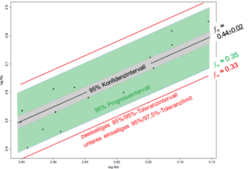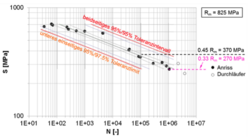All influencing factors described above exhibit some statistical scatter: loading, material strength, flaw size, detection limit of non-destructive testing. To account for the respective uncertainties, suitable safety factors have to be chosen. However, it must be noted that the trend of downsizing component dimensions as well as every safety factor to the lowest possible allowed value will lead to an increasing number of component failures.
Methods of robust optimization aim at considering simultaneously all these influence factors and find that combination of values that leads to an optimal product excelling by efficient material usage as well as high reliability, tolerating the unavoidable slight changes in component dimensions, material properties and external loading.
Especially in safety-critical applications, it is useful to assess the diverse sources of scatter separately in detail. By means of probabilistic methods one can get more precise information about the dependence of the failure probabilities on the various influences from material, manufacturing and operation; the allowable failure probability must be supplied from a risk assessment by the product manager, customer or (as in aeronautics and railway transport) by the responsible public authorities.




















